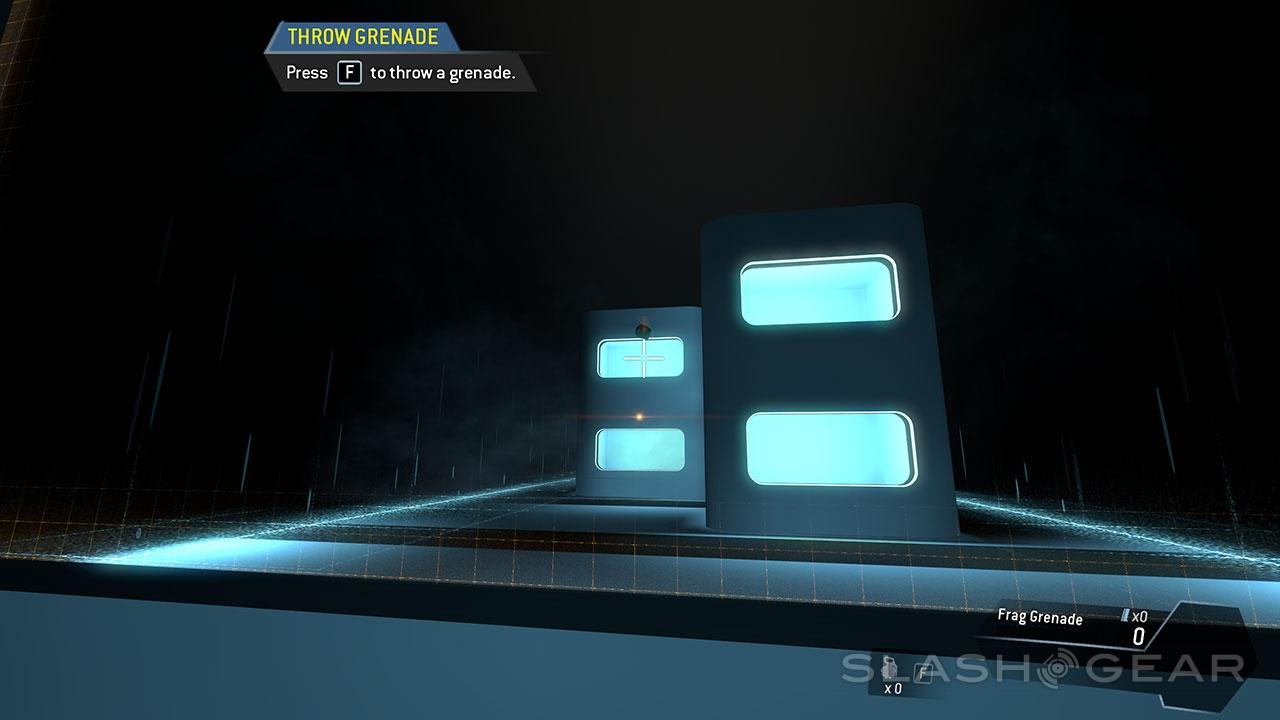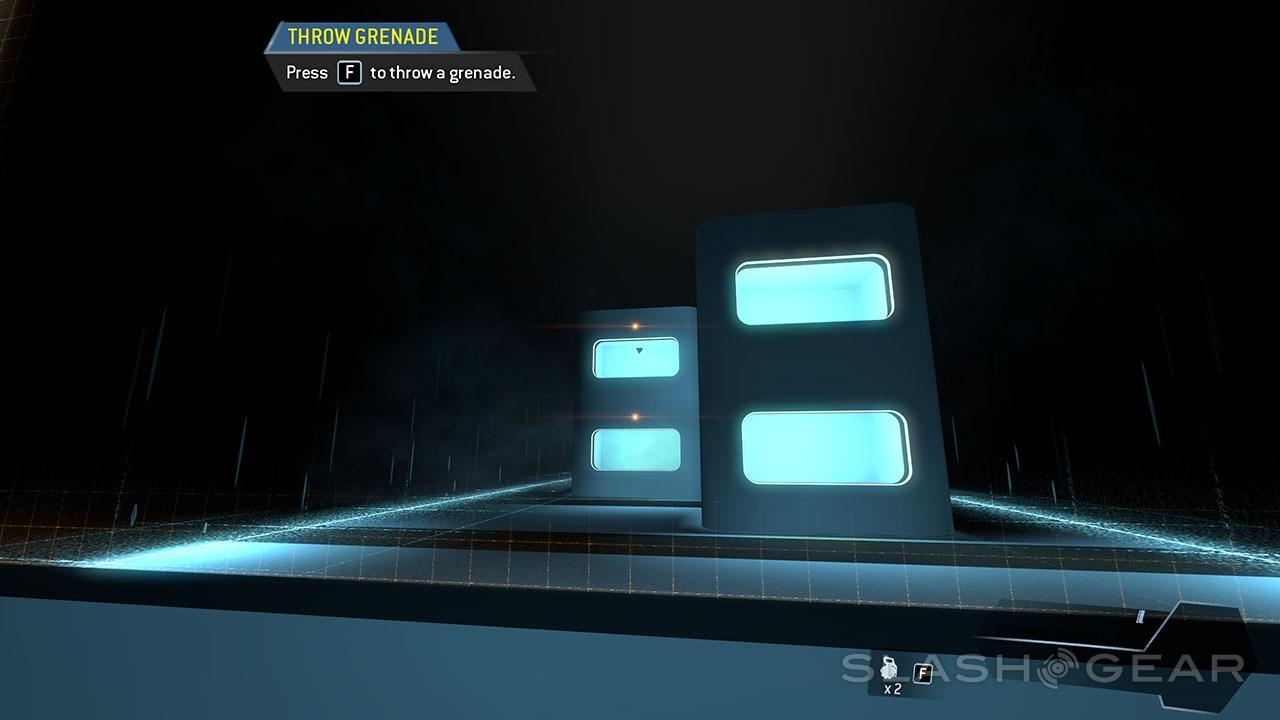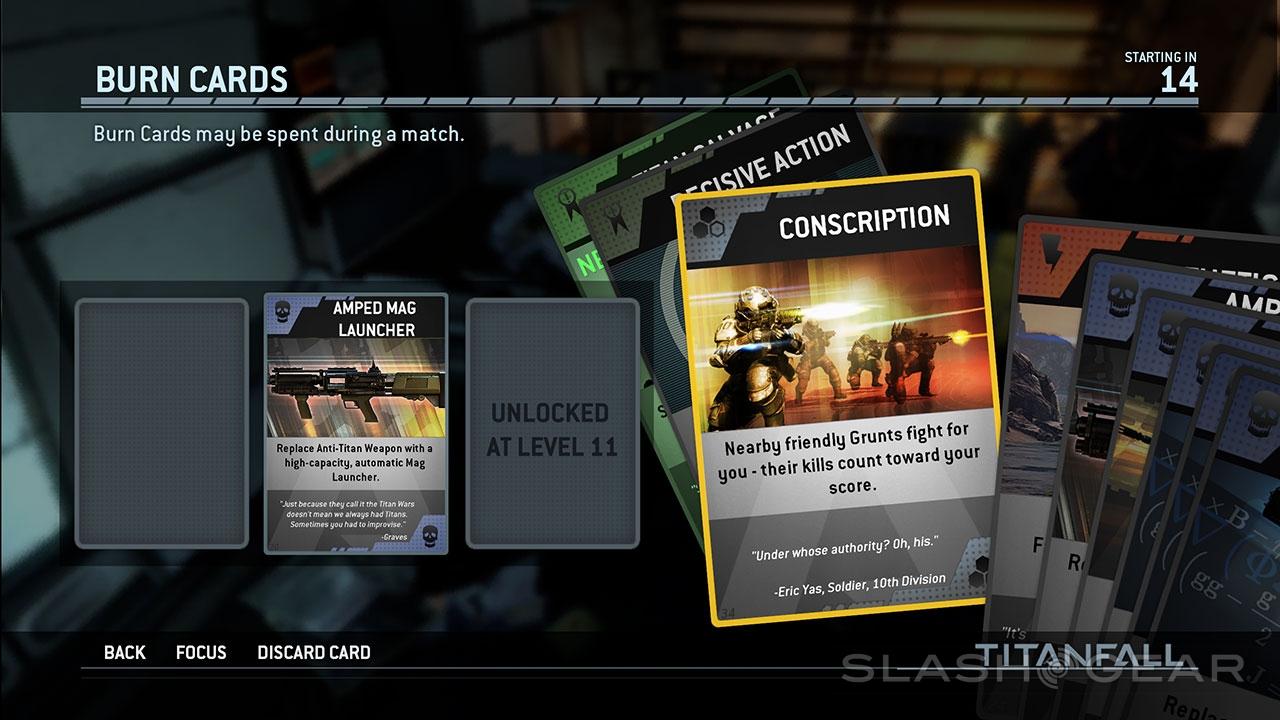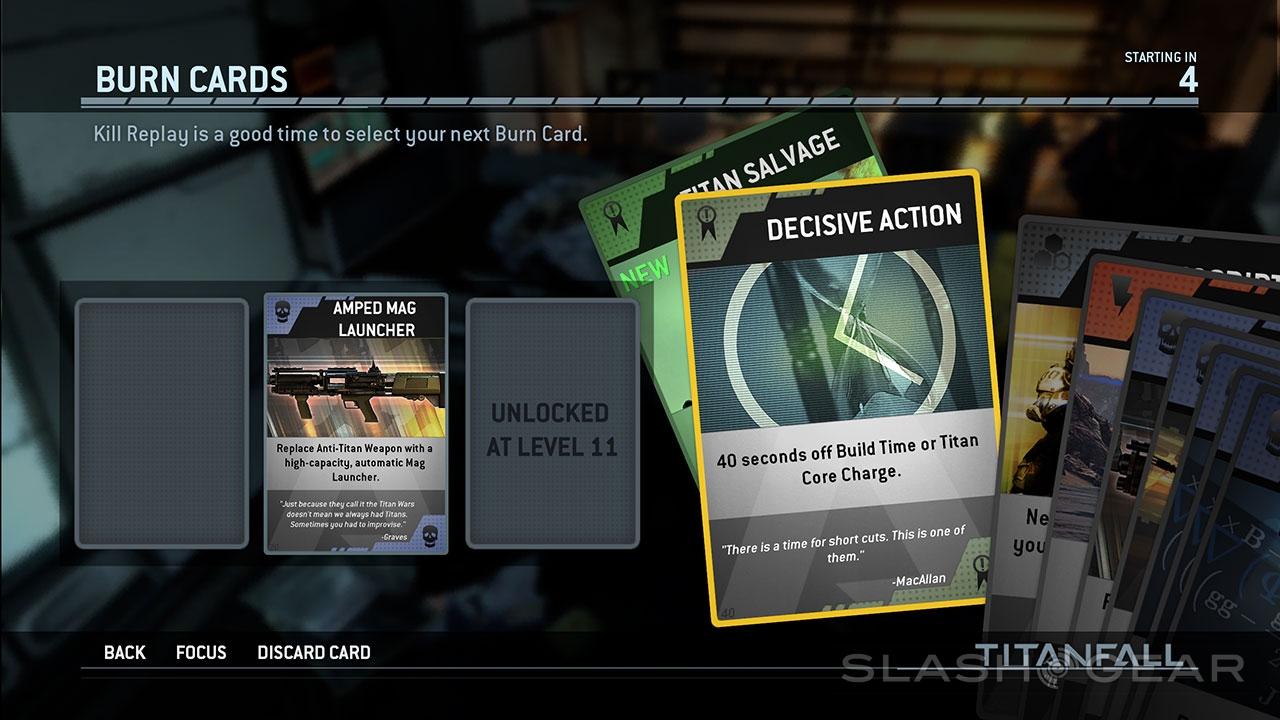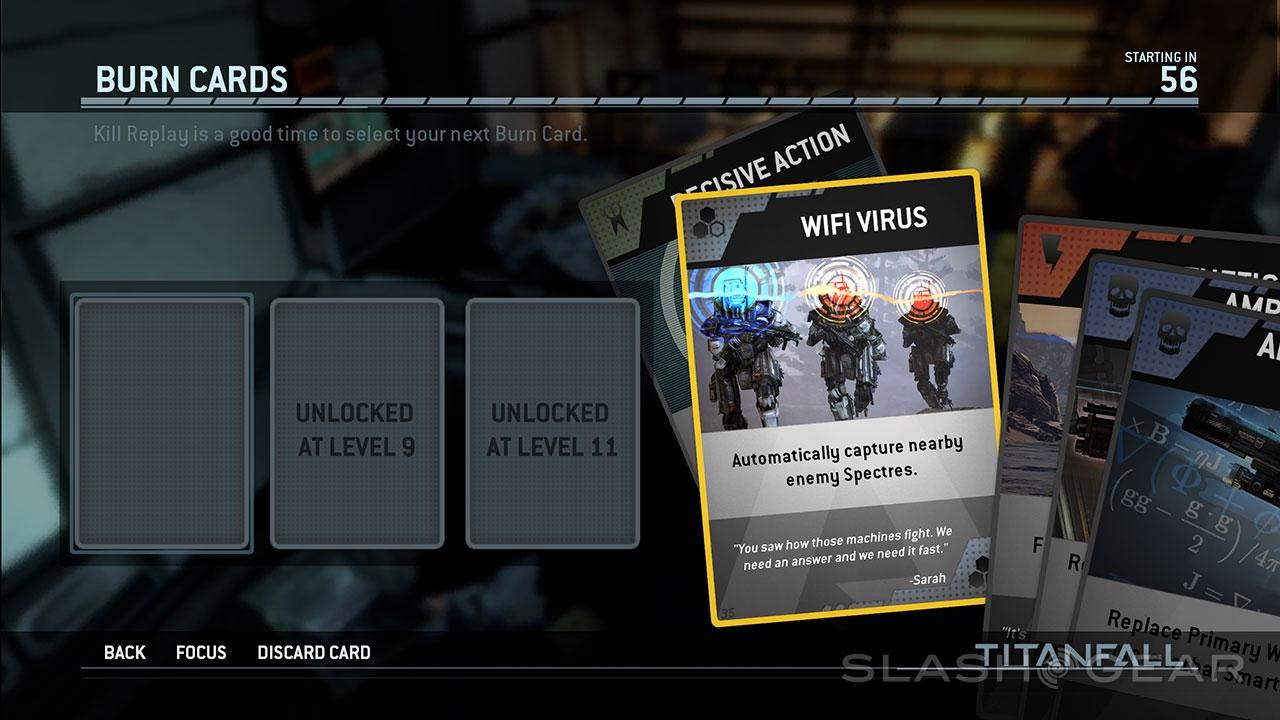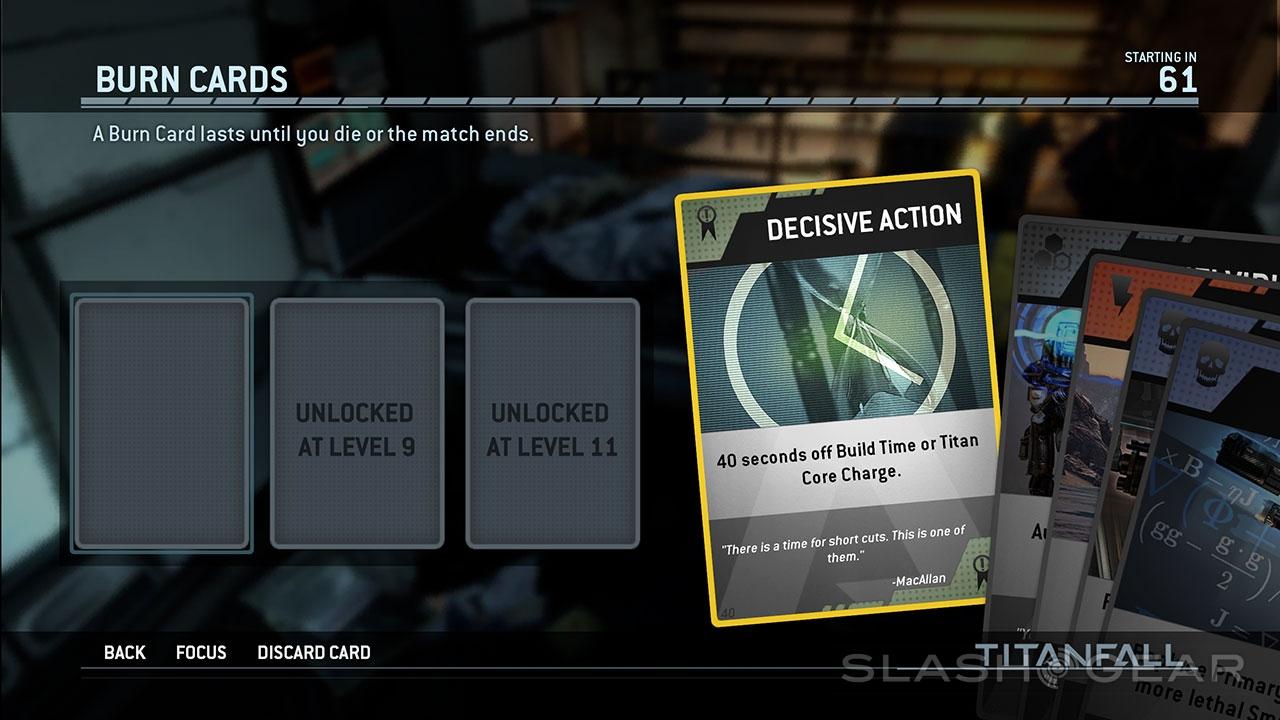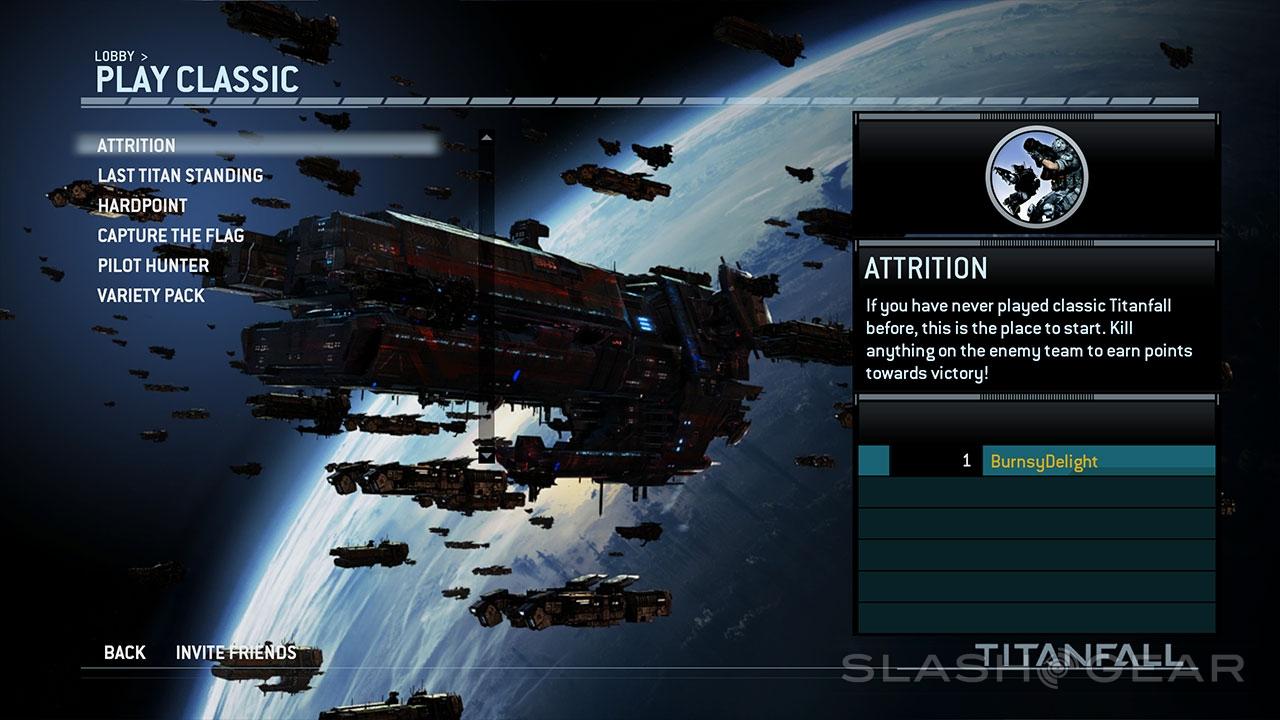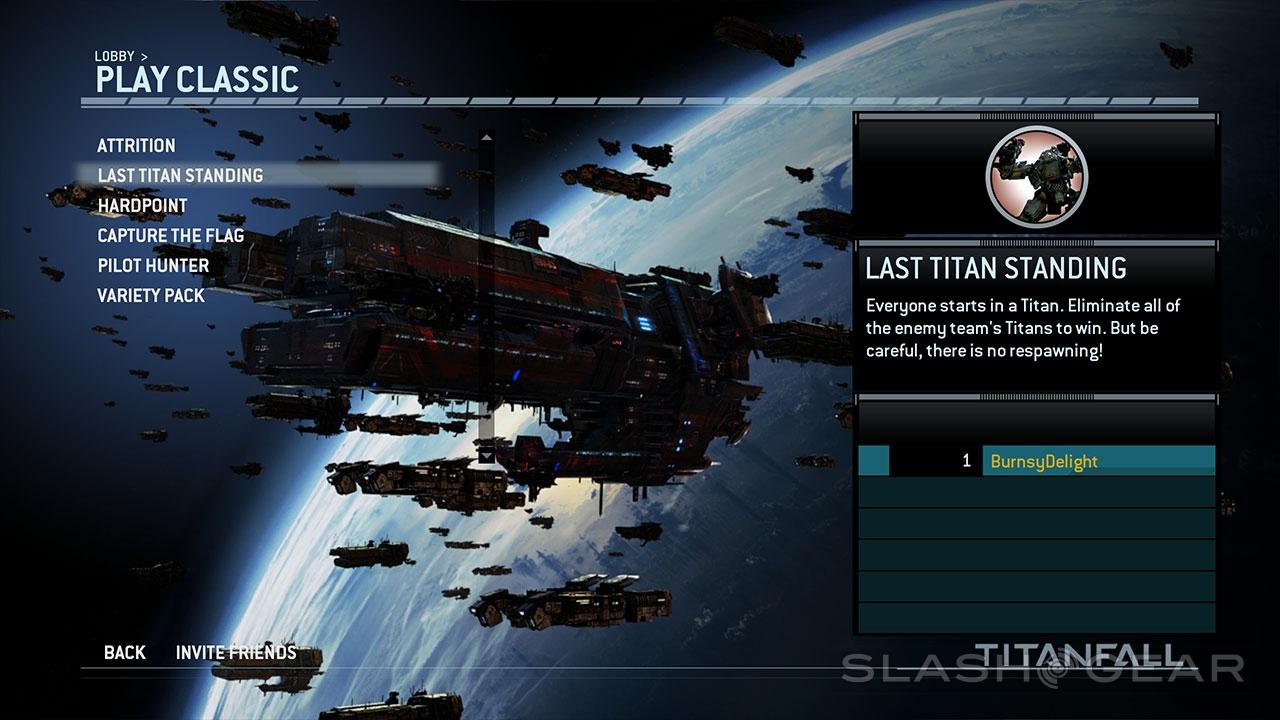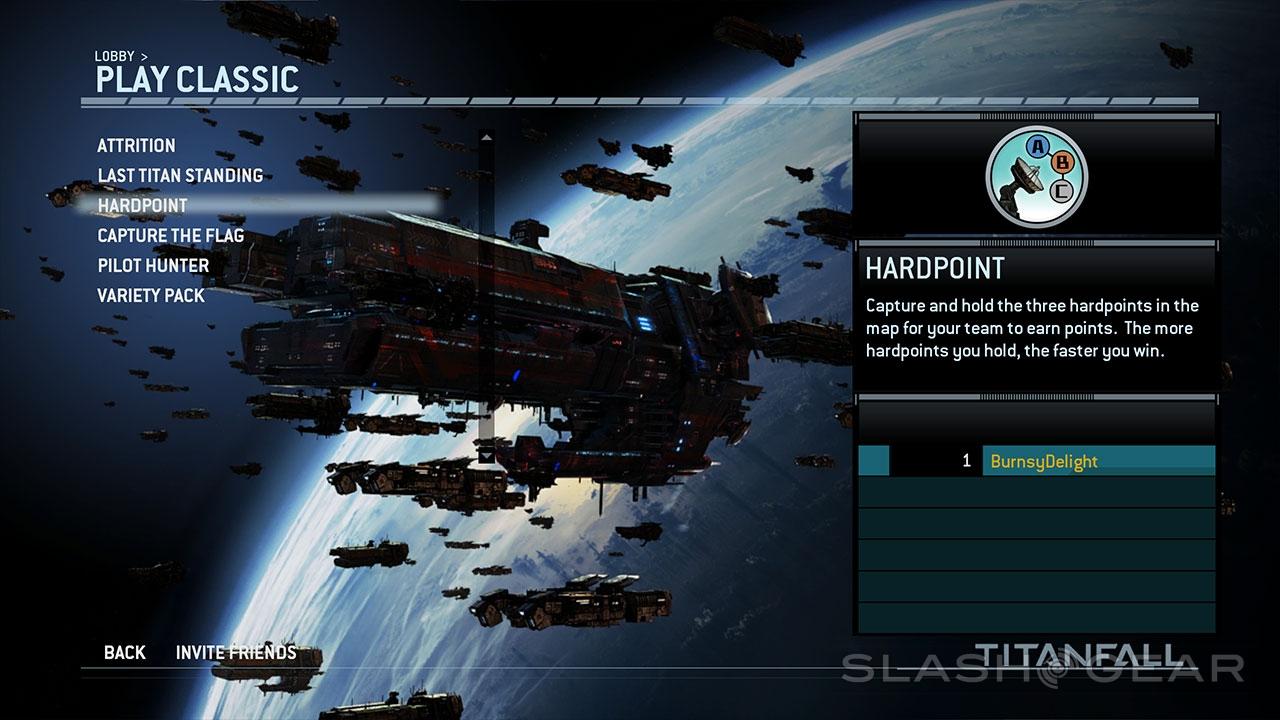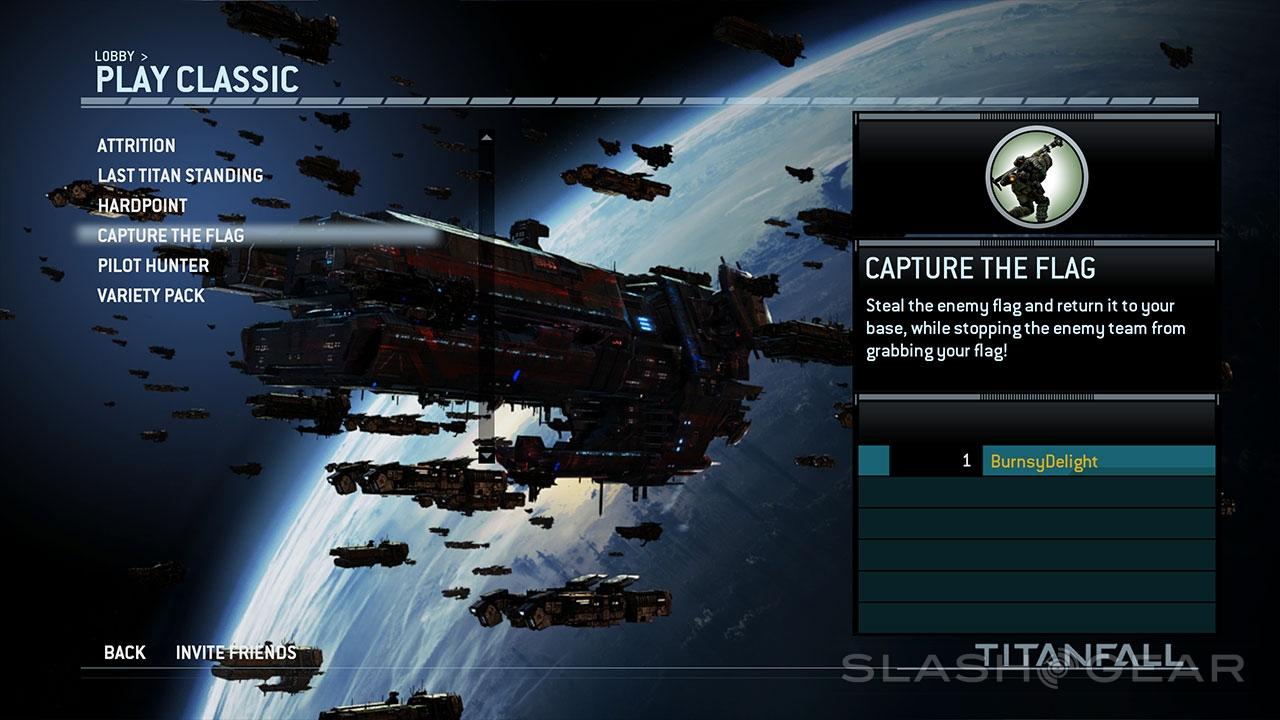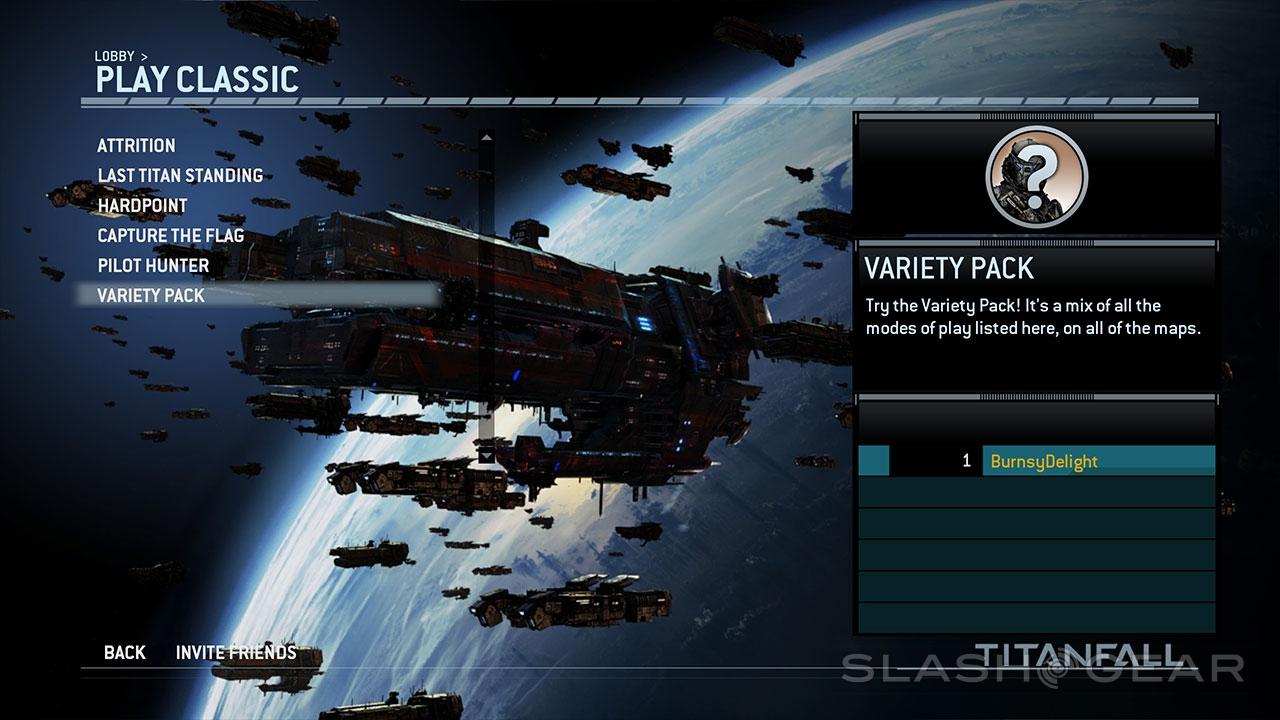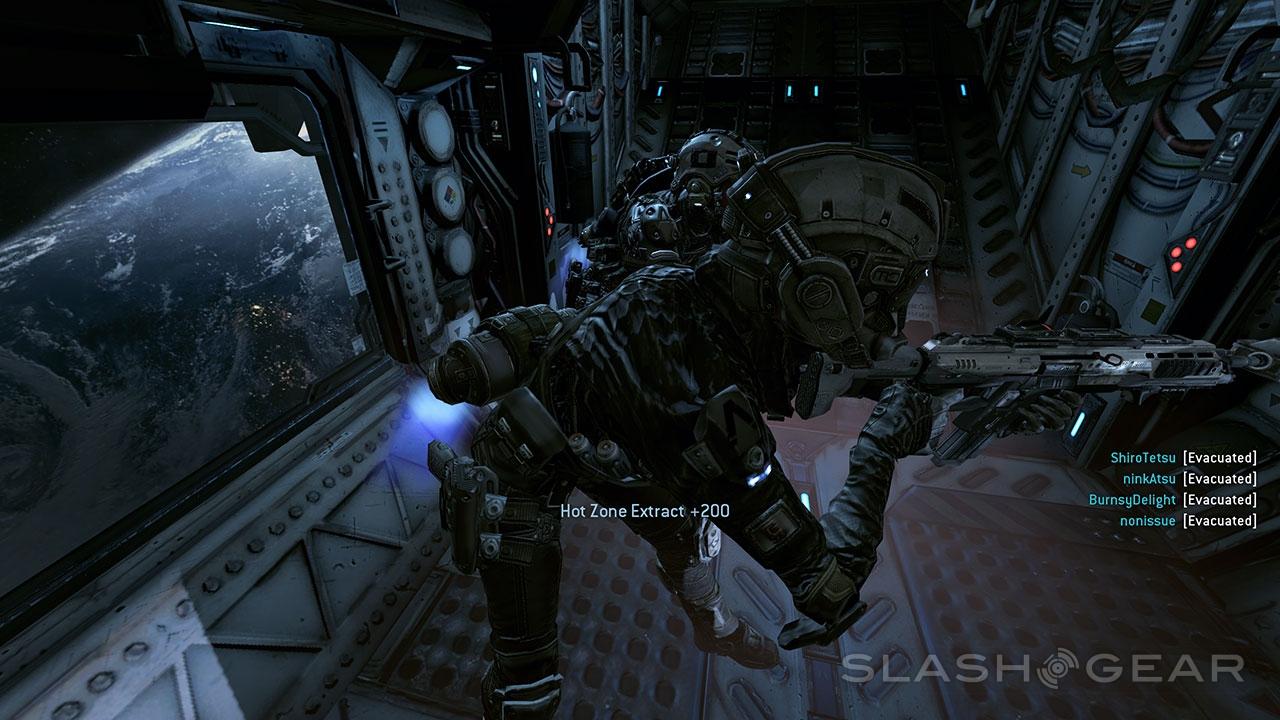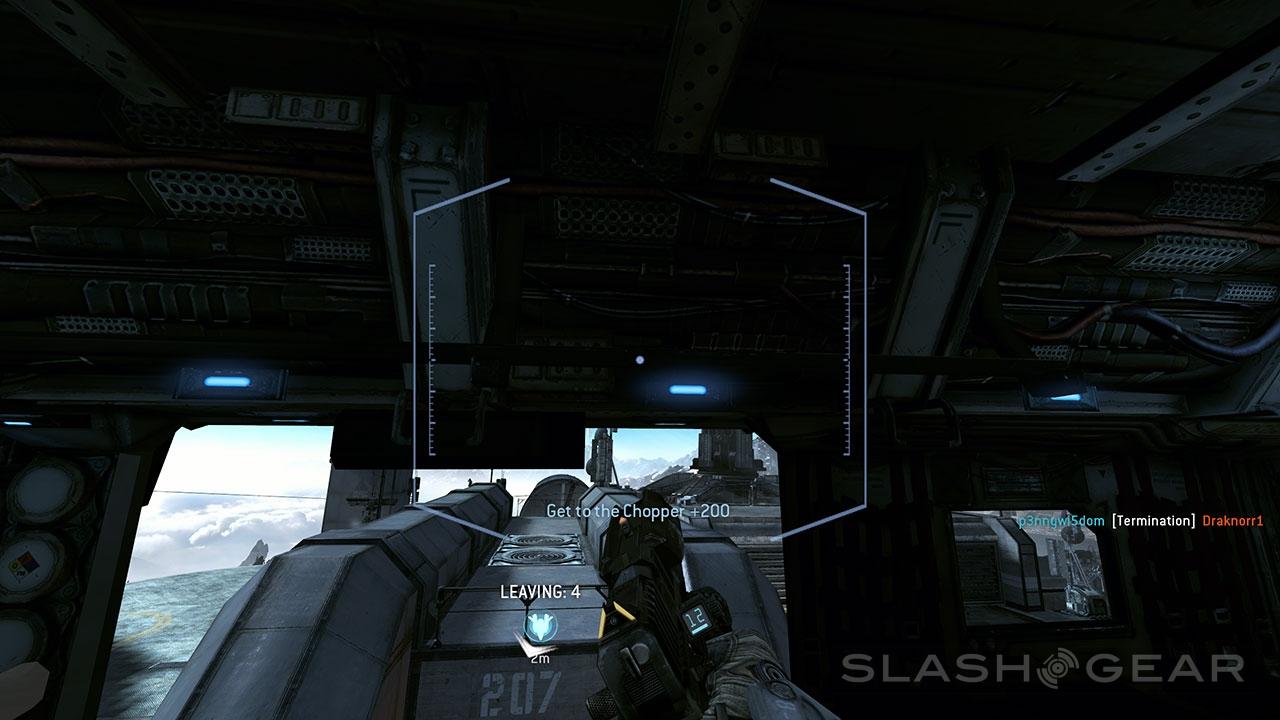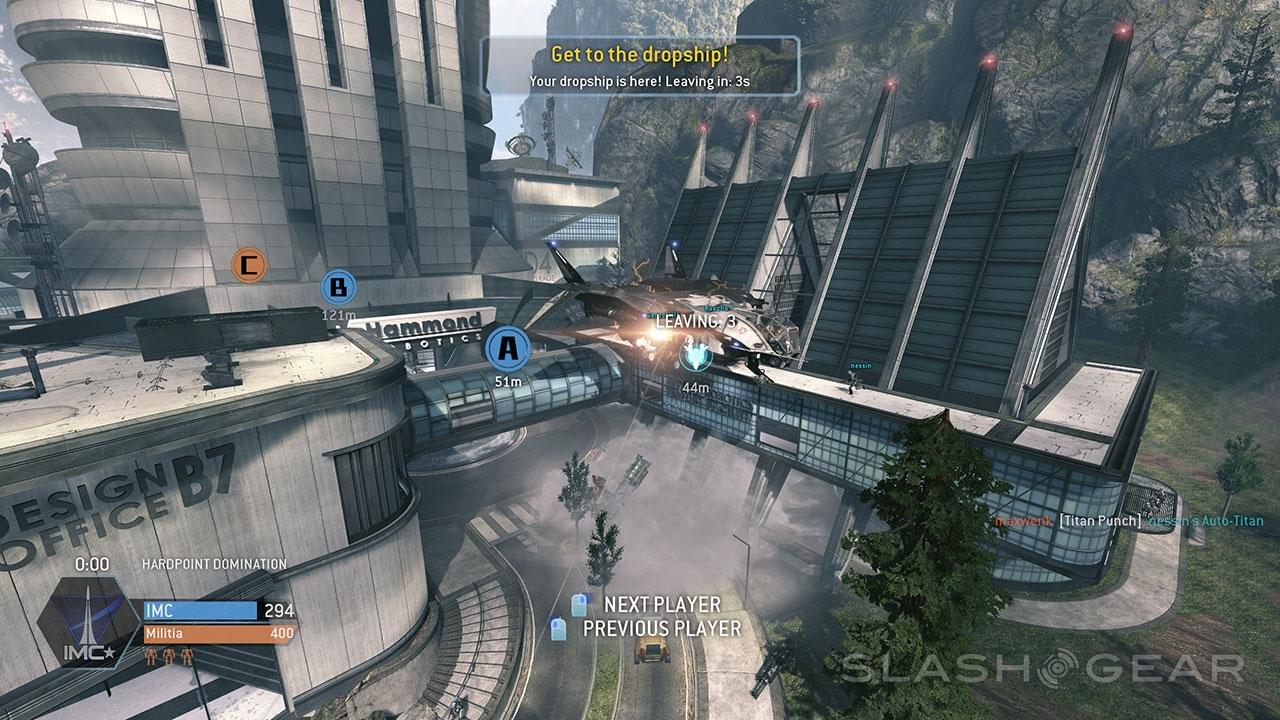Titanfall Review
Prepare to be wowed. In Titanfall, the developers at Respawn Entertainment have made a massive name for themselves in the industry at the same time as they've ushered in a new generation in multiplayer gaming – a new generation that's long overdue. The team at EA Games have made no secret about Titanfall being a game-changer, and based our tests with the final build of Titanfall in the real world with real, live servers for Xbox One and Windows, we'd have to agree. Titanfall quite simply takes every genre it belongs to out a whole new door.Before you dive too deeply here without knowing, it's important to note that this review reflects both the Xbox One and PC gameplay through Origin on Windows 8 with an NVIDIA GeForce GTX Titan GPU and Haswell Intel Core i7 processor power under the hood of a custom-built gaming PC. Differentiations are noted where applicable.
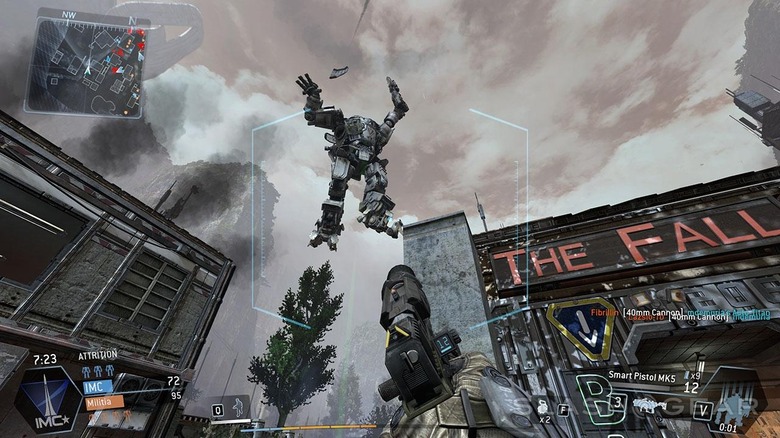
When you call a Titan into battle, it's called Titanfall. This is because when a Titan is ready for deployment, it's dropped from space, its drop-capsule exploding hundreds of feet overhead before it drops with a smash into the ground ahead of you. As the Titan falls, you can run towards it, pressing the action button as you leap into the air as the Titan hits the ground, this resulting in the Titan catching you in mid-air, inserting you then into the Pilot's seat. This sequence encapsulates the thrill of the game – and it's not even combat, yet!
The first thing to strike us when starting up Titanfall as a Pilot was the fluidity of the motions involved in running, jumping, and switching between all manner of modes. Executing a double-jump or running up the side of a wall felt natural – it seemed as though the Pilot and Titan Training missions at the start were just exercises in surprising the user with ease of use cases in high-flying action.
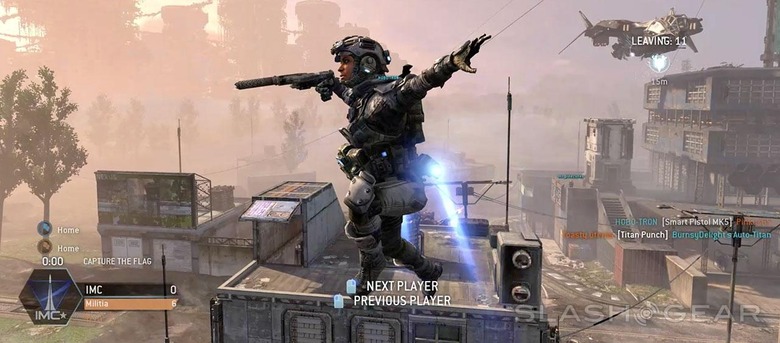
Once we ran up a wall and double-jumped atop an adjoining building in our first few moments of play, multiplayer gaming changed forever. It was as if we'd been living in a 2D world and Titanfall opened our eyes to a new dimension of gameplay. Titanfall turns a flat plane of gameplay into Thunderdome. Twelve Pilots enter – it's your choice how many Pilots are allowed to leave.
Pilots
There are two factions of human pilots, one the Militia, the other the IMC (Interstellar Manufacturing Corporation). This war is fought on the Frontier, fought between the civilian-made Militia attempting to repel the IMC from using their colony resources. The IMC rolls in top-notch battle suits and shiny new Titans. The Militia is much more rough-looking, being comprised of whatever-works combinations of ways and means.
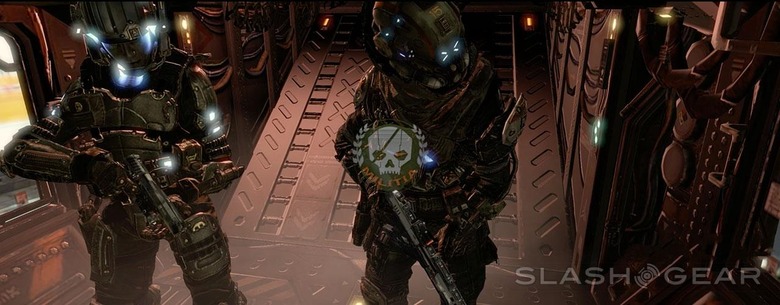
The Militia represents the military arm of the Frontier systems' territorial defense systems. In this group are homesteaders, pirates, bandits, and mercenaries. Also included in this group is a faction called M-COR, aka the Marauder Corps, dressed in green and rolling hard with a logo with two pistols and big ol' bullets.
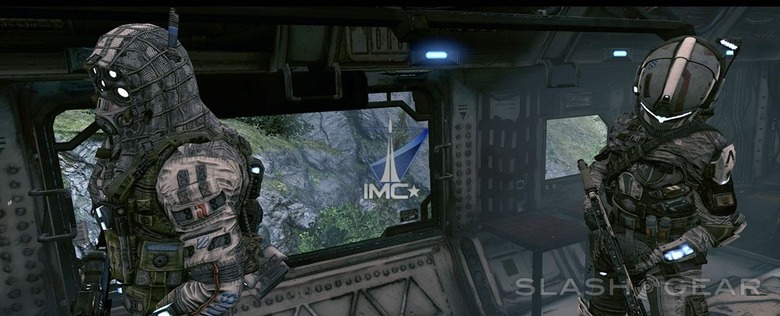
As the Interstellar Manufacturing Corporation (IMC) is invading the colonies, looking for resources to keep Earth in business, we're generally looking upon them as the bad guys. The IMC and the Militia are sort of like the Empire and the Rebellion in Star Wars – though again, it's not quite so simple.
The interesting twist here is that the developers aren't necessarily pushing one side or the other as the clear heroes or villains. In the non-traditional Campaign Multiplayer bits of the game, you've got the ability to play through twice – one with the IMC, another with the Militia. Seeing the game from two perspectives builds on the game's unique delivery – while more than one faction is available to play in most multiplayer elements in first-person shooters, the single-player element is generally presented from one side only.
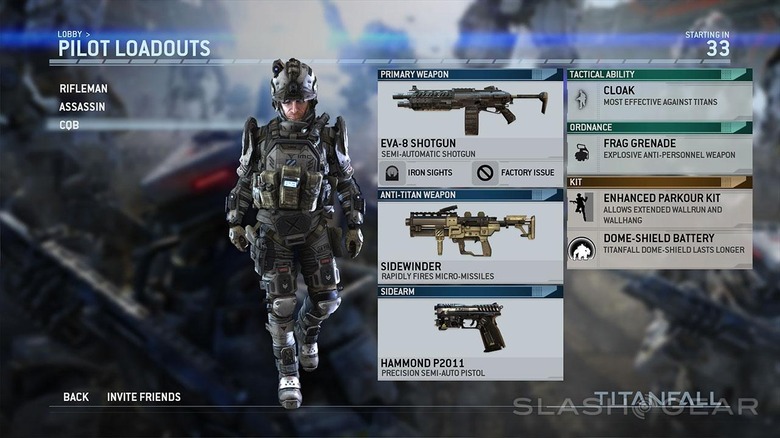
Equipped for Close Quarters Battle (or close quarters combat as it's known elsewhere with the title CQC). As such, this pilot is equipped with the EVA-8 shotgun, Sidewinder AT-SMR (Anti-Titan Weapon), Hammond P2011 pistol, Frag Grenade, Cloak, enhanced parkour kit, and a choice between an enhanced parkour kit for extended wallrun and wallhang or a dome-shield battery for your Titan.
As you're working with a weapon that shoots micro-missles, another that shoots shot, and a primary weapon that's a close-range semi-automatic pistol, you're going to die unless you get up close and personal with your enemies. Enemies engaging the CQB at close range will have little chance of success without grenades or rockets – provided the CQB has good aim.
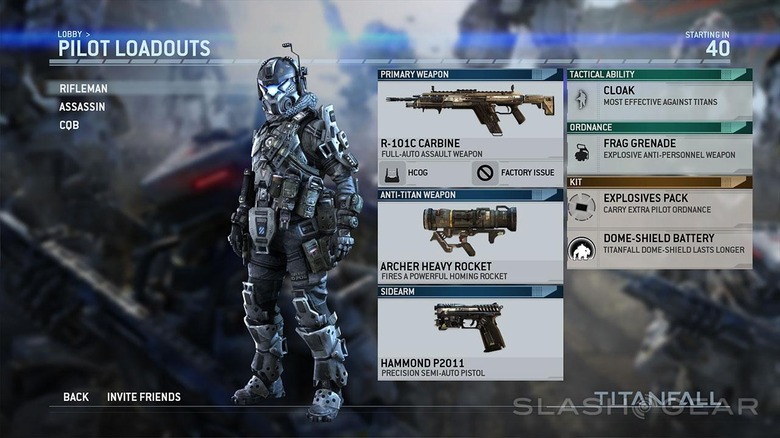
Made to cover the middle-ground, this pilot is made to be a "Jack of All Trades" and master of switching between taking down pilots and titans. The Rifleman's initial loadouts include an R-101C Carbine automatic assault gun, Archer Heavy Rocket (Anti-Titan Weapon), and a Hammond P2011 semi-automatic pistol.
You'll also roll with cloak, frag grenade, and a choice between an explosives pack (for an extra ordinance, like more frag grenades) or a dome-shield battery for your Titan. This pilot is meant to make up most of your team's forces, overwhelming the enemy with balanced tactics.
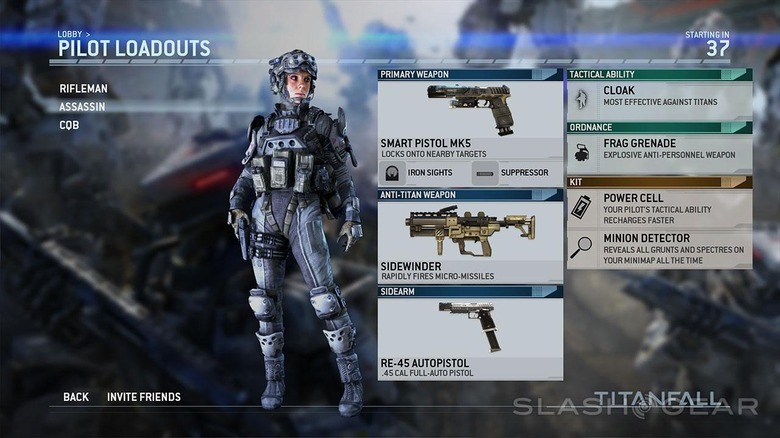
If the CQB's ideal range is as close as possible, the Assassin is just the opposite. Titanfall brings a unique bit of flavor to what the assassin generally is in the FPS genre by introducing the Smart Pistol Mk5, suggesting the Assassin remain a stealth pilot while pushing them close enough to lock on to multiple targets.
The Assassin works with the Smart Pistol Mk5 as a primary weapon along with a Sidewinder AT-SMR (Anti-Titan Weapon), RE-45 Autopistol .45 cal automatic pistol (you'll have to aim a bit better with this one, but it packs a punch. With the Assassin class you'll also have cloak, frag grenade, and a choice between Power Cell (tactical ability recharges faster) or Minion Detector (showing all Grunts and Spectres on your minimap as they appear on the battlefield.)
Weapons
There are around 20 basic weapons in the game, along with at least as many "kit" items, tactical abilities, and ordinances you might choose when you choose loadouts for gameplay in Titanfall. We're going to concentrate on a few of the more important bits and pieces as they contribute to gameplay in areas that were either above or below our judgement of average implementation. For example the R-101C Carbine: it's an awesome automatic assault rifle, but it does just what we expected it'd do.
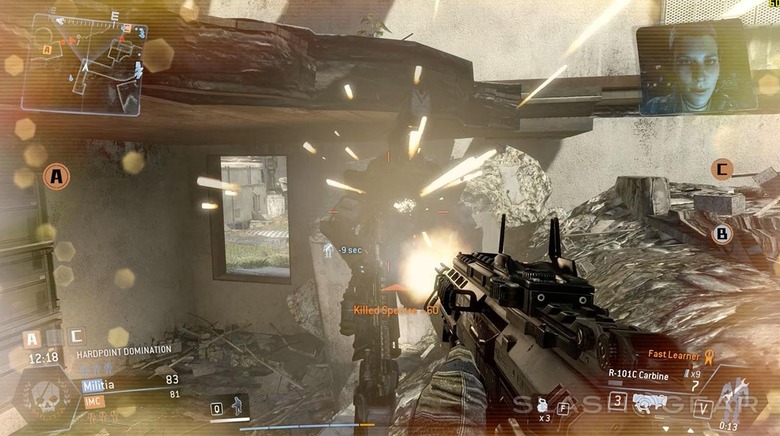
The Smart Pistol Mk5 is one of the most important weapons in the game. With the Smart Pistol Mk5, the pilot will come within range of enemies, lock on (with bright, augmented reality red arching lines and meters), and fire with seeking shots. The Smart Pistol Mk5 works with a single lock, single shot kill for AI pilots while pilots require three locks and a little more time in your sights.
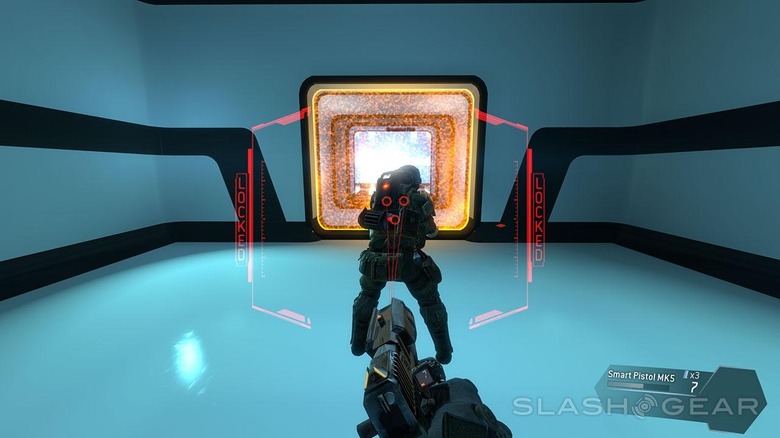
Pilots can also use the Smart Pistol Mk5 as a standard, semi-automatic pistol if they wish. This weapon is so powerful and effective that it's been the subject of some scrutiny in Beta tests – by all means, it seems at first like you've got a Golden Gun from 007.
One shot kills seem too easy. But once you've used it for a while, the Smart Pistol Mk5 shows itself as an instrument you'll need some practice at using in a way that will be as effective as an automatic rifle in the hands of an experienced shooter.
One of the stranger weapons in Titanfall is the Charge Rifle. This unit works with "hyper-velocity rounds" which virtually eliminate the lead you'd normally have to place on a target. If your target is moving, even when they're at a distance, you won't need to fire a round into your target's path – just fire straight at them and (provided you're a good shot), you'll connect. This weapon is a longbow-DMR (designated marksman rifle), but it's unique composition allows much quicker reloads than the average sniper-friendly firearm.
Each of the Pilot Anti-Titan Weapons are highly entertaining, working with massive-impact rounds and larger-than-average bulk. With the Mag Launcher you're firing magnetic grenades which explode on impact – fire them close enough to a Titan and they're pulled (magnetically) toward their target.
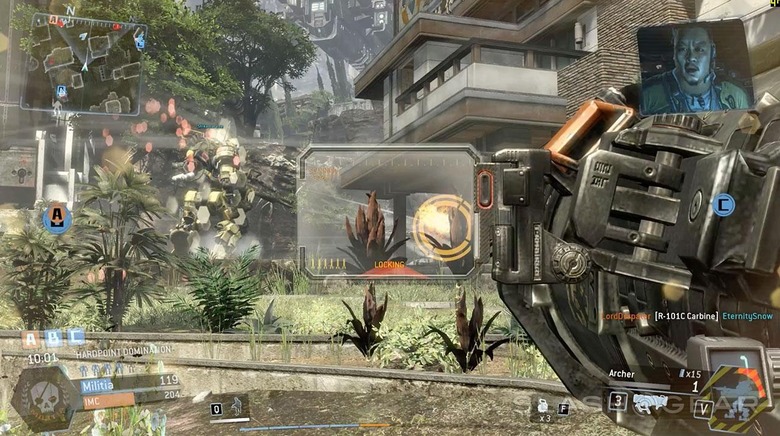
The Archer Heavy Rocket has been the most effective Anti-Titan weapon we've used as a Pilot, locking on to a target after a few moments in the pilot's sights and firing a homing rocket with massive damage potential. The Sidewinder isn't the most accurate or effective of the bunch, but it's abundantly fun to use due to its wide-spread micro-missle salvo.
For lovers of explosives, there's the full Pilot Ordnance collection. The Frag Grenade works just as you'd expect it to, with massive damage and a limited number of tosses during a match. The Arc Mine is tossed like the grenade, but instead of bouncing you'll find it sticking to any surface – any surface at all.
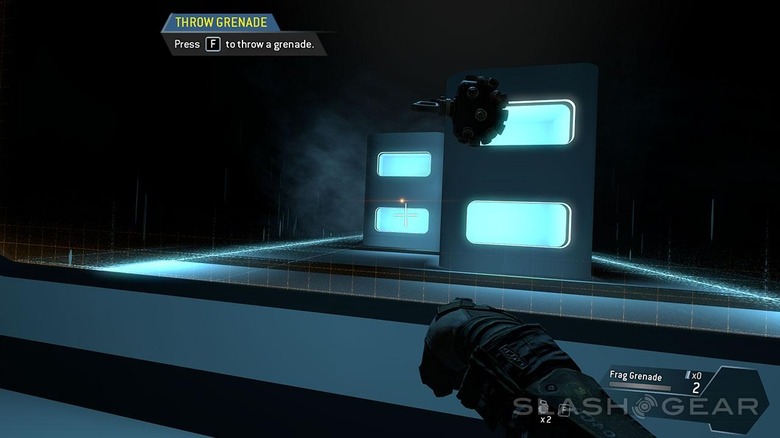
Once exploding, the Arc Mine will cause normal damage as well as semi-blinding Titans and Pilots inside its range for a short period – wildly effective. The Satchel Charge works in two steps – toss the charge first, then (after running far enough away), manually detonate the charge for a highly-powerful explosion.
Titan weapons are similarly entertaining to use – using the Arc Cannon, for example, allows you to hit a single target, the bolt of lightning you've shot then bouncing off and attaching to additional targets within range. This includes enemies around corners, below, and above – and if you happen to be surrounded, targets will be zapped behind and to the left and right as well.
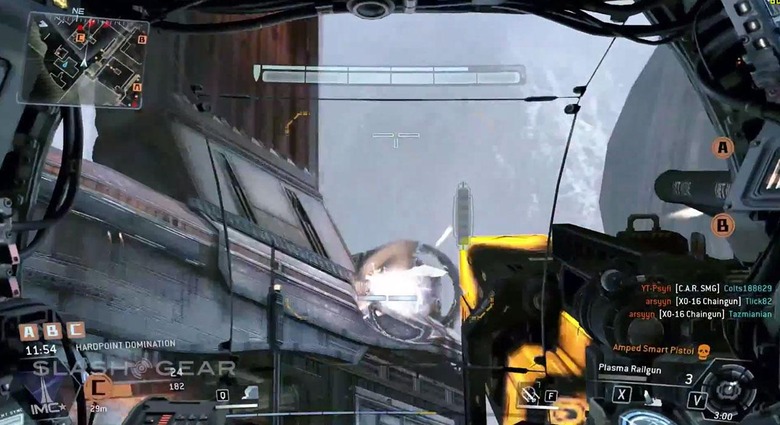
There's also little more pleasing than charging up a Plasma Railgun with a Titan. Holding down your aim button results in the gun charging up, a meter showing several rectangles lighting up as the end of the firearm begins to glow red. Like a rattlesnake starting to shake its tail, you're not going to want to be on the receiving end of a Plasma Railgun glowing red-hot.
Titans
There are two default class Titans able to be utilized by a pilot right from the start of the game, with a third available at level 3. Once you begin to level up, the Titan custom class option is unlocked – from there you'll be able to change loadout slots as you see fit. The three default classes are Atlas, Ogre, and Strider (at level 3), representing balanced, beastly, and swift.
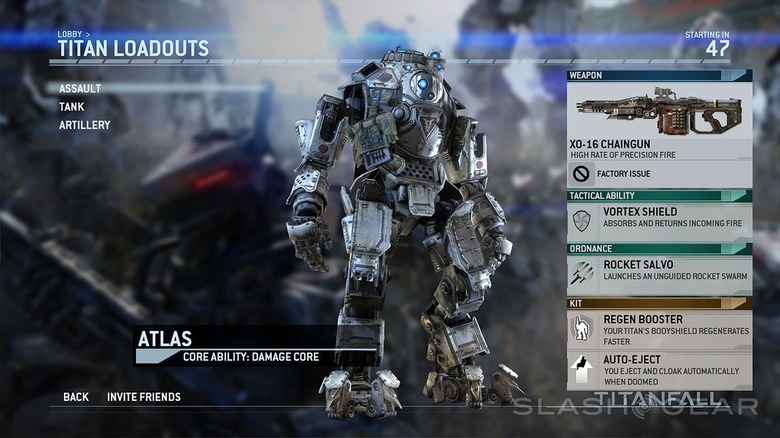
The Atlas or "Assault" Titan is well balanced, working with moderate shields and weapons, able to move faster than the Ogre, but not as fast as the Strider. This is the Titan you'll see representing the game in posters and models at the game's launch. Here you'll have two dashes – that's two quick thrusts in the direction of your choice, as you've experienced in Titan training.
The Damage Core ability of this unit allows you more damage from you ballistics for a short period of time – this, as with the rest of this machine's abilities, make it easiest to get used to if you're new to the game. You'll find most new players selecting the Atlas as it's the first one to appear in loadout screens. Experienced users will learn the Atlas quickly and move on to the Strider or Ogre to quickly outflank – or outlast – the Atlas in battle.
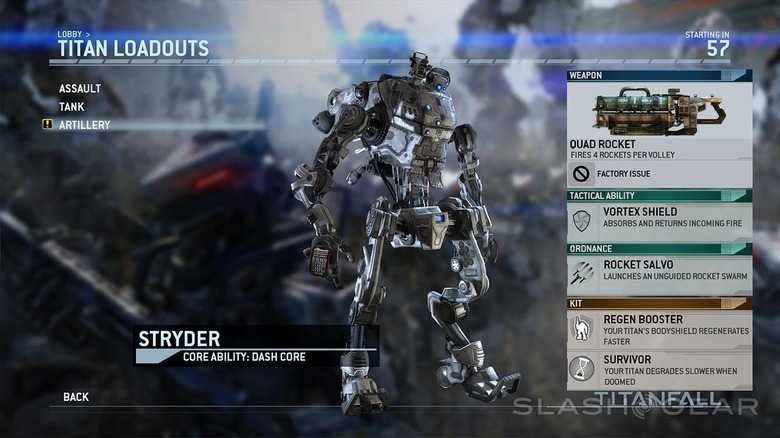
The Strider or "Artillery" Titan is the fastest of the bunch. Working with the lowest shields, this Titan requires that you be a bit more aware of your surroundings, outflanking your enemies with quick decisions about how to blast and dominate. This is reflected in the Strider's Core ability – "Dash Core" – giving you infinite dashes.
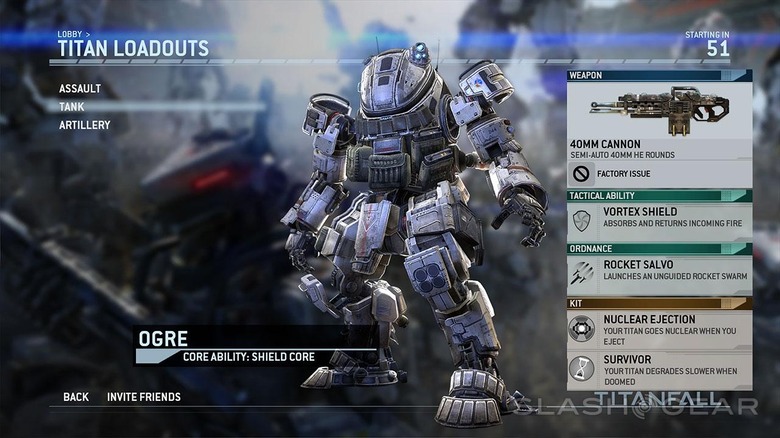
In the Ogre or "Tank" Titan you've got the rhino of the bunch. You've got no dashes, but the highest shields of the three basic Titans by far. Your Core ability also increases shields (Shield Core), making this Titan a real beast.
The Ogre may be the most difficult of the Titans to get use to using, as moving significantly slower than the other two classes can get frustrating for a new user. The Ogre lasts the longest in the field of play, though, under an experienced pilot's control, especially when you factor in its loadout kit's "Survivor" ability: lasting longer than the other Titans when in "Doomed" mode.
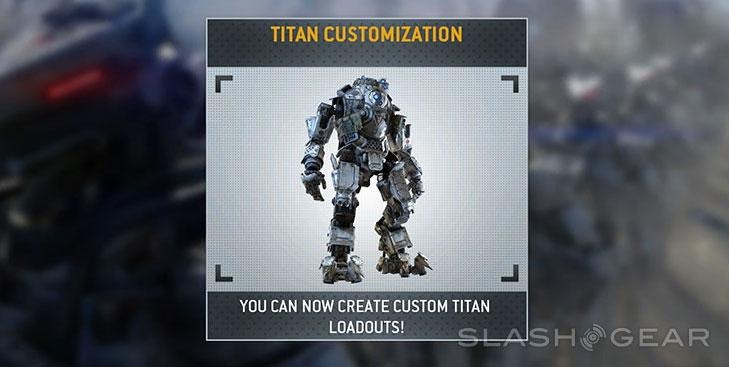
Once you advance in levels, you'll begin to be able to customize your Titan. At the moment, this just means changing loadouts, but we can't imagine a future in which we're unable to change the paint colors and looks of the machine as well. We're waiting already.
Experience Points
Farming Minions – You'll get +20 points for killing a Minion, +25 points for hacking a Spectre (instead of just killing it), and +500 points for completing a Challenge. Titanfall uses the actions you use to earn experience points for decreasing the cool down time of your Titan – the faster you mow down enemies, the quicker you get a new Titan, as well.
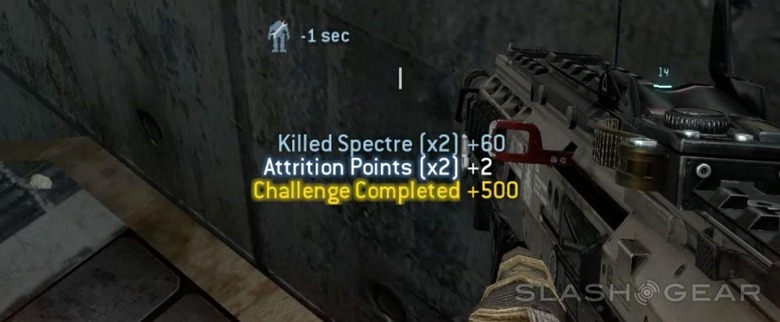
Killing a pilot (a non-AI opponent) is worth +100 points, while killing multiple enemies in a short amount of time can result in a "Rampage" which can be worth a variety of points based on how many enemies you've knocked out rapidly.
Earning a Burn Card – through any one of a variety of means – gives you +25 experience points, while completing a match (win or lose) gives a player +200 experience points. Winning a match (Victory!) gives each player +300 experience points.
AI
The Spectre is one of two kinds of Minion, this one robotic. It's much smaller than a Titan, and not nearly as imposing – they're hardly a threat on their own, but in groups they can score a shot that'll take a pilot down.
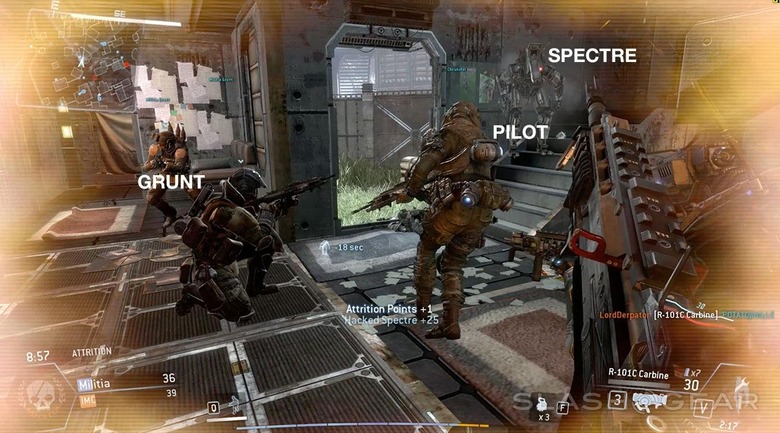
The Grunt is a human AI unit, also coming in squads and ever-so-slightly more imposing than their Spectre counterparts. Grunts cannot be hacked, but they can be killed essentially just as easy as Spectres and – like Spectres – aren't worth nearly as many experience points as player-run pilots or Titans of any kind.
Minions are, at least at the start of this game, generally appearing to fill out the battlefield. They keep you active. While PvP games of the past have you sneaking around, shooting at everything that moves because it's always another player, here with minions we've got diversity.
If you can get close enough to a group of Spectre units, you can hack them to turn them against their masters. You'll be doing this with your Data Knife, a device that you'll remember from the Training sequence from the start of the game. You'll see this hacking ability appear when you're close enough to a Spectre: "Hold X to Hack" on Xbox One or "Hold use to Hack" on PC. If one Spectre is successfully hacked, the rest of their squad will be hacked as well.
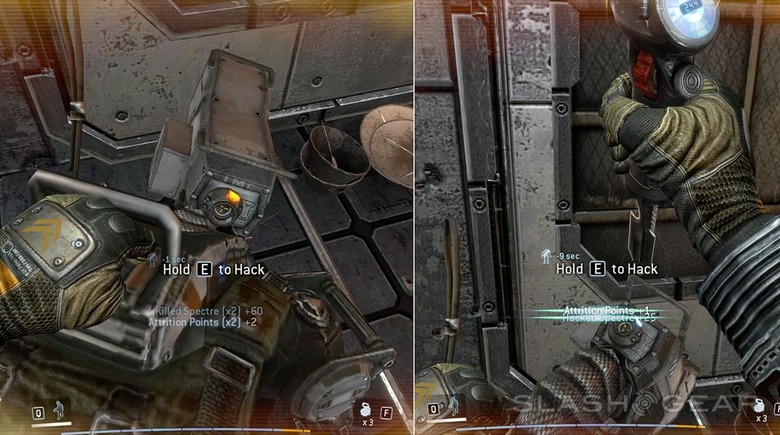
The only bad thing about this – and perhaps reason enough not to hack in the first place – is that these units are so easy to kill that hacking seems to simply be an exercise in giving your opponent more experience points. In Attrition you get a single point and +25 experience points for hacking a Spectre, on the other hand, so if that's better than killing a grunt for +20 points, feel free – this also gives you +1 Attrition point.
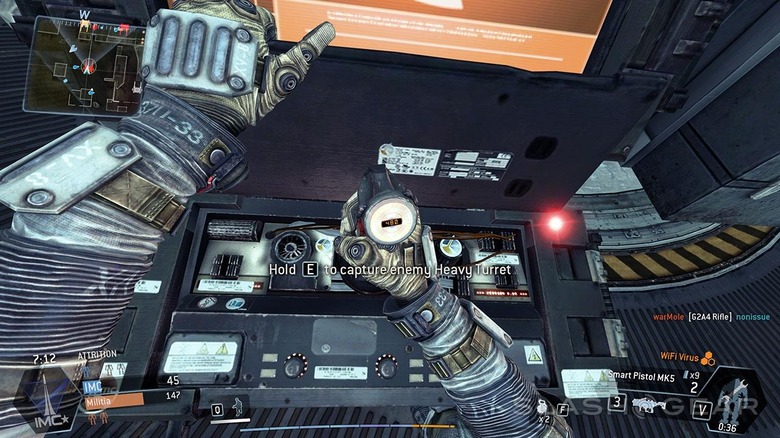
You'll also be able to hack other items in the game, like turrets. Here there's a much clearer reason to turn the enemy's hardware, as turrets are able to dish out a lot more damage than a Spectre in a much shorter time.
Also note – once you hack something – anything – it works for you specifically. This means that if you hack a group of Spectres, they follow you around. This can be really excellent if you're looking to surprise the enemy with a barrage rather than just a tiny folly.
Unique Moves
Jumping on to the back of a Titan is called "Rodeoing", and it requires only that you leap up and toward the Titan as a pilot. Inside the Titan, the opposing pilot will get a notification that they've got a pilot on their head, allowing them to hop out and battle person-to-person. Hopping on a Titan's back allows the pilot to rip open a panel on the Titan's head, exposing bits that, when shot, will bring the Titan to Doomed status.
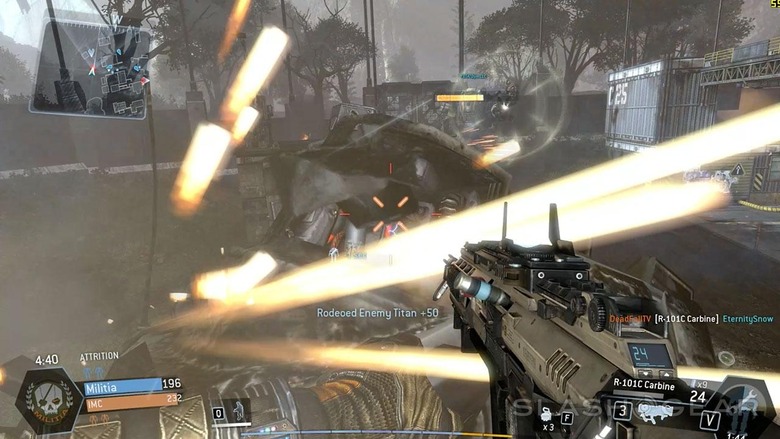
If you're on the back of a Titan while in Doomed status and the pilot inside the Titan hits eject, you too will be blasted skyward – there you can feel free to have an in-flight battle with your new best buddy, epic style. Also available for repelling pilots rodeoing Titans is electrified smoke, damaging pilots if they stay inside the plume. You can also Rodeo a friendly Titan and ride along – the only kind you can't Rodeo is your own Titan: there you can only pilot.
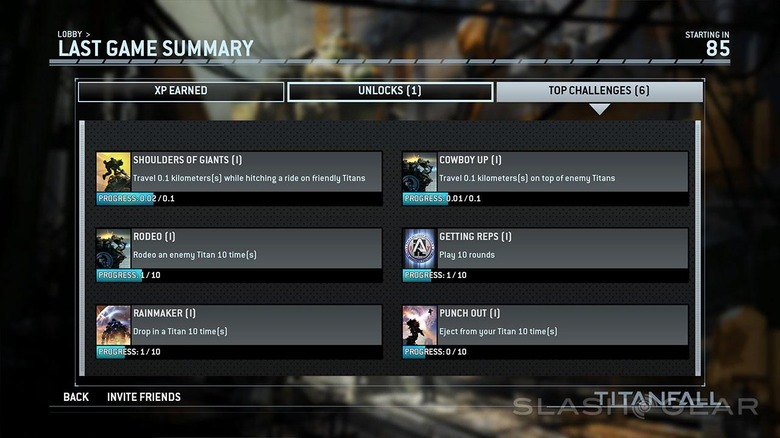
If you've just ejected from a Titan, there are several things you can do. If you've ejected from your Titan with another pilot on your Titan's back, you'll both be blasted upward several hundred feet, left to free fall, and up in the sky you can shoot one another.
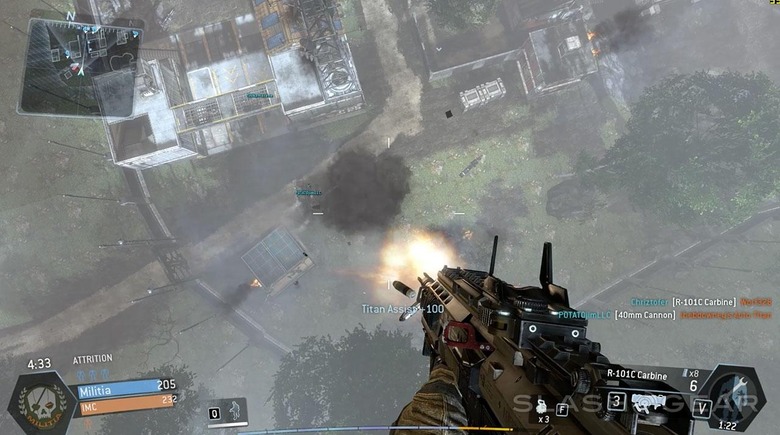
This is one of several ways you can destroy an enemy in mid-air. You can also fall onto the field of battle – the ground or on top of any building on the map. You can also fall onto a Titan – this can be particularly satisfying if you fall onto the Titan that's just destroyed yours, proceeding then to send theirs to Doomed status immediately thereafter.
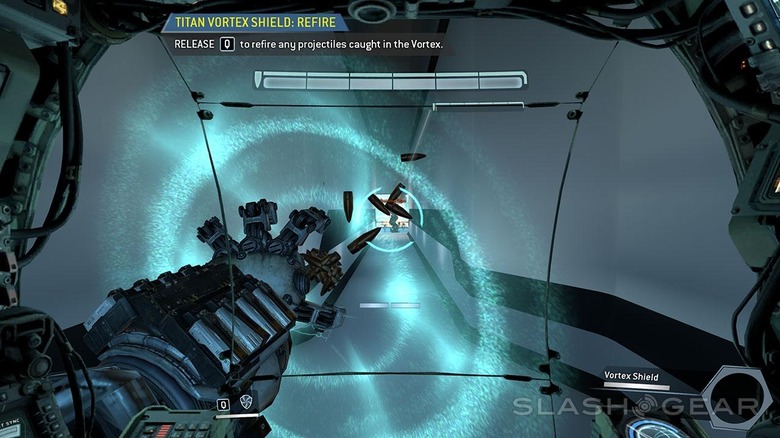
The Titan Vortex Shield is something between a move and a weapon in the field of play. Pressing whichever button you've assigned to this bit, the Titan Vortex Shield will stop all incoming ballistics and keep them hovering in mid-air. Letting go of the button you'd been holding results in these explosives being shot full-speed back in the direction you're aiming. Rather harsh when used effectively, but not always as easy to work with as it seems at first.
Burn Cards
Burn cards are a rather unique new element in the PvP universe, allowing a short-term bonus to hit your unit during a round. This ability will last from the point you launch until the time you die – unless you're playing a mode like Last Titan Standing where you can potentially keep the Burn Card ability through the end of one round and into another – just so long as you haven't died. These cards are "burned" on your wait screen after you've died during a match but before you've re-deployed.
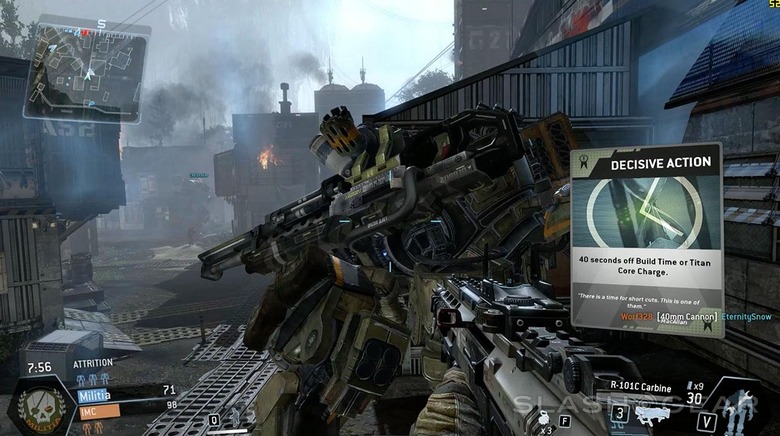
"An envelope has been left under your door. It has no post mark of identification.
Your performance in the field has been noted. This envelope contains a pack of cards. They are not playing cards. They are favors. When you wish to redeem one, burn it. The favor will follow.
- An Advocate"
Burn Cards remind us that Respawn Entertainment are looking to make a name for themselves in the multiplayer arena. Where before you'd have been safe expecting the enemy to select from a pre-set number of classes and weapons, Titanfall adds an element of surprise in Burn Cards, usable once and forever disintegrating afterward.
While this sort of gameplay has appeared before – consider even the oddity of Michael Myers in the Onslaught DLC for Call of Duty: Ghosts – never before has this "collect and use" model been implemented so smoothly.
Classic Mode
There are two overarching types of gameplay in Titanfall, one called Classic Mode. Here you're playing in a multiplayer arena in game modes you may recognize in their most basic form. These include Attrition, Last Titan Standing, Hardpoint, Capture the Flag, Pilot Hunter, and "Variety Pack." The last is a random selection of the other modes, while the others are a little less obvious.
The oddest concept here may be Pilot Hunter – the aim is to kill your opponents. Without AI elements – as in other FPS games – this is always the aim, but here in Titanfall, there's a unique mode that must be called out to direct you to take on your real player-controlled enemies to earn the most experience and win the game. Capture the Flag is fairly self-explanatory, working with 2 flags at any given point and pushing you to use your wall-running, double-jumping, and Titan-controlling creatively.
The same is true of Hardpoint Domination – another name for "king of the hill", in which you aim to "control" a number of points in the map the longest. Last Titan Standing uses the unique nature of the game in a way that's simplest, pushing you out into the match with your Titan right off the bat – you can get out if you want, but it's all sudden-death: no respawns!
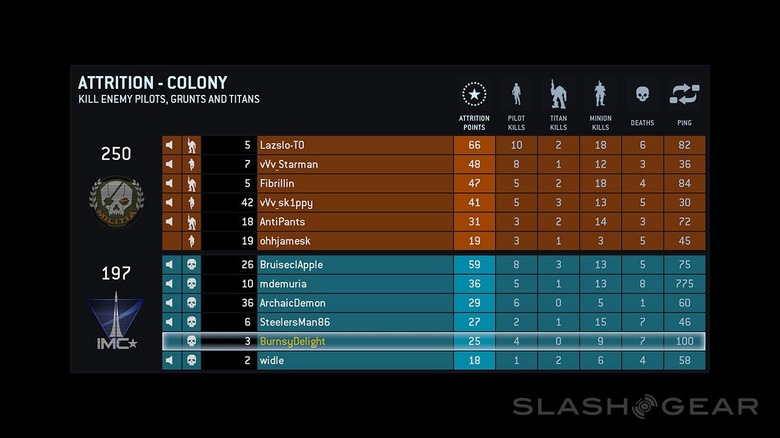
Attrition is the mode you'll find most players playing from the start. You'll earn points for actions – killing first and foremost – including Titans, Pilots, and AI. Earn points the fastest and your team wings – while the heaviest team can often take advantage of the lesser, we've found that the most unique spreads have won over the most matches we've seen so far. Rodeo those Titans and turn the tables, take snipers from behind, and make sure you're making use of grenades tossed into windows and up stairways.
Above you're seeing the Attrition gameplay mode from an Xbox One. Note that this has been exported using the Xbox One's built-in game clip exporting system which has been known (believe it or not) to degrade the overall picture quality. From there it was edited and uploaded to YouTube where it's presented in its original 720p resolution. Below you'll see more Xbox One action as well.
Protip: Besides the obvious differences in video quality, you can always tell the difference between Xbox One and PC gameplay on Titanfall by looking at the key symbols in the Pilot readout near the bottom of the screen. If you see LB and RB, you're looking at an Xbox One.
Multiplayer Campaign Mode
With Multiplayer Campaign Mode we're left wanting a whole lot more – in a good way. While it's always nice to have the whole plot wrapped up nicely inside a single game, it's clear that Respawn Entertainment means to push this universe well beyond the bounds of the one title. Below you'll see the first of the Multiplayer Campaign Mode missions from the rebel Militia point of view in its entirety.
As the plotline moves forward, you find that the line between good and bad in this game is not cut and dry – not a bit. Even within the Militia, for example, you'll find factions that appear as early as the second mission in the collection. Have a peek next at the mission called "The Colony" to see how complicated it all gets right off the bat.
As Respawn Entertainment pushes out additional content with Playfight – with live-action movie content, no less, we'll see if the public is as ravenous about the inner workings of this universe as they are about its multiplayer gaming aspects. Given the long-lasting effects of series like Halo, we can't imagine they'll have a tough time finding an audience.
Epilogue
At the end of a session of play, you'll have an Epilogue. During this time it's almost as if a second match has begun. It's more like a shoot-out in hockey than it is a normal match, each kill resulting in "sudden death", so to speak, without the ability to re-spawn.
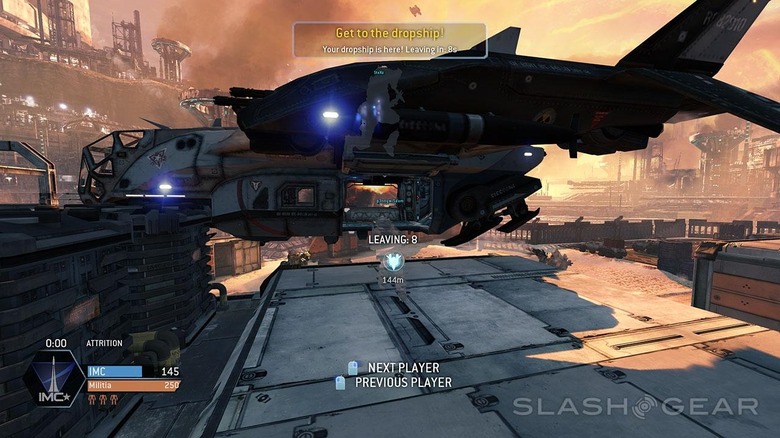
The goal in this portion of the game is – depending on if your team has won or lost the match – to get to an extraction drop ship to escape or to destroy the entire opposing team before they escape. If you've got enough firepower when your opponent's drop ship takes off, you can also potentially shoot that drop ship down before it escapes.
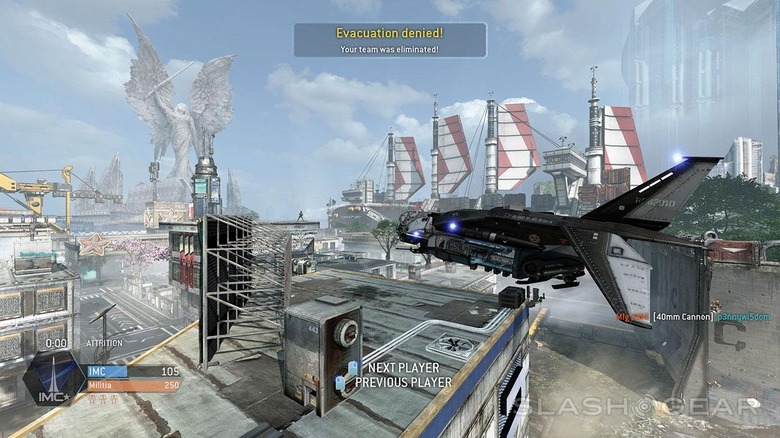
The end sequence can bring a losing team a sense of victory in escaping, while stopping an escaping, losing team can add to the sting of loss – and the joy of victory, of course. Destroying a drop ship is not easy – a single pilot will not be able to take out a drop ship on their own unless they've got some especially massive weapons – multiple Titans will do the job with relative ease.
Controls
With the Xbox One, Respawn has presented six different pre-set controller layouts, each with their own unique title. Below you'll see the whole lot, including Default, Evolved, Bumper Jumper, Bumper Jumper Pilot, Button Kicker, and Fruit Loop.
Thus far we've found Fruit Loop to be best for rolling with an CQB, as we're able to access the Fire and Melee buttons as close to one another as possible. You'll be running up on opponents and cutting them down with a tap or two.
Default seems to be as balanced and smooth as possible for the Rifleman, while the Assassin can be utilized creatively with Evolved, allowing you to jump and shoot with a LB, RT combo rather than needing to press A then RT. That's left hand, right hand rather than right thumb, right index finger. Little oddities can make all the difference.
For PC gameplay, you'll be centering your hands on the WASD area of the keyboard and on your mouse – traditional, for the most part. Moving between weapons is naturally done with a mouse wheel, while choosing an Anti-Titan weapon requires that you press the number 3. Kicking an opponent in the face requires that you tap C – hitting C from behind an opponent will have you executing them, neck-break style. All very satisfying.
Sound
The music in Titanfall is fabulous. Emphasizing the two major factions as well as different maps and periods of gameplay, the soundtrack for Titanfall is amongst the best matched to its content. While sound inside the game is largely based on explosions, clangs of metal, and voice acting – each of these being of particular high quality as well – it's the soundtrack that sticks with us between sessions.
Titanfall's music is composed by Stephen Barton, also known for his composing work with Call of Duty 4: Modern Warfare as well as a couple of Metal Gear solid titles. He also contributed music to the film Kingdom of Heaven back in 2005, now bringing some high-end scale to Titanfall here in 2014.
Development
Respawn Entertainment have said some – but not one whole heck of a lot – about downloadable content for Titanfall. What we do know is that traditional updates will be available for free and that DLC will be coming too, for a cost. There's already a Season Pass available for DLC content for the next year. Until we get that content, we'll just have to guess at what it'll bring to the field of battle and/or to the multiplayer campaign mode of the game.
Meanwhile, it's important to note that this game runs on the game engine known as Source. Because of this, there's more than your average amount of potential for the title to be modded for 3rd-party play.
Don't mistake this comment for anything having to do with hacking – instead what I mean here is that eventually the game may be able to roll with higher-definition graphics, changes to the aim of the game, and full-on restructuring of gameplay. Until that happens, we'll be crossing our fingers in anticipation.
Wrap-up
Even though we've got some extensive work to do judging the game on DLC play, downloads and updates, we feel secure in calling this game a real winner. While competing titles focus on massive bits of plot line, character development, and single-player content for one-direction gameplay, Respawn Entertainment have tossed out all preconceived notions about a multiplayer-only game being a high-end game (AAA, if you please).
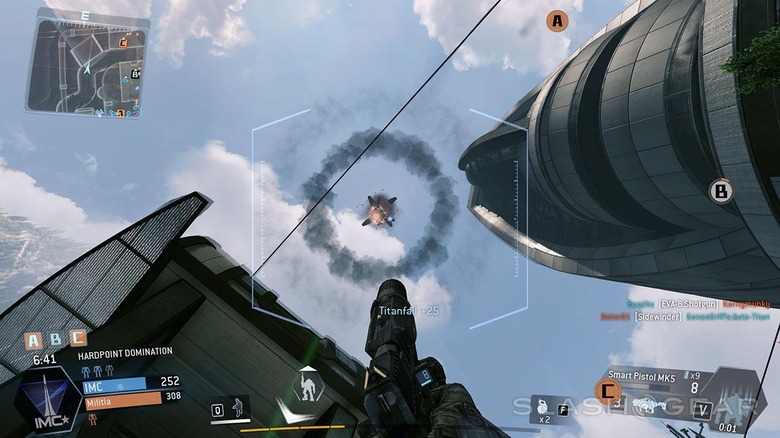
In the multiplayer first-person shooter environment, there have been few that've changed the way we play the game. We became addicted to the genre when the Half-Life mod Counter-Strike was developed in 1999. In 2001, Halo was developed by Bungie for the Xbox, turning the console into product that we'd only really enjoyed Golden Eye on before (locally, of course, on the N64).
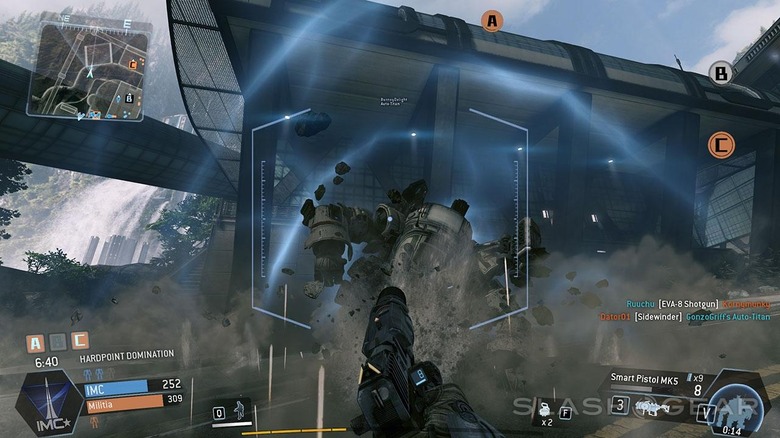
When Infinity Ward developed Call of Duty: Modern Warfare in 2007, it was apparent that everyone was going to need to get onboard with their model of multiplayer combat or risk being abandoned by the masses. Key creators of that title specifically left Infinity Ward and, as FPS multiplayer titles of all kinds have become an exercise in relative stagnation, (save graphics updates, gun modifications, and the addition of dog control,) these developers formed Respawn Entertainment.
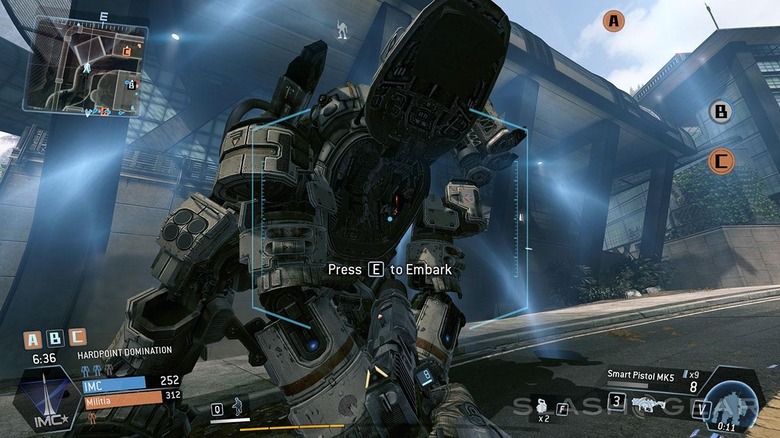
Because of this reformation, Respawn Entertainment appears to come out of nowhere with Titanfall. But here as the game launches, it's apparent they've not been idle. Titanfall is the next generation of gaming. Not just in the first-person shooter genre, and not just for multiplayer. Everything about this game suggests that it's the beginning of something big, even as it stands on its own as a game we'll certainly be playing for years to come.

